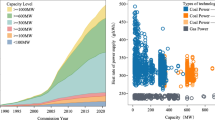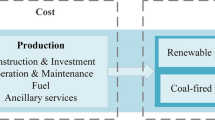Abstract
China’s power generation capacity structure should be adjusted due to the needs to reduce \(\hbox {CO}_{2}\) emissions. Now, we should take carbon dioxide emissions as a constraint in satisfying the electricity demand. Through an optimization model, the optimal power generation capacity structure under the constraint of carbon dioxide emission reduction is achieved. Also, the macroeconomic influences are accessed through a computable general equilibrium model, which results from the increment of power generation costs owing to adjustment of power generation capacity structure. The results show that, the implementation of renewable energy planning has significant positive effects on \(\hbox {CO}_{2}\) emission reduction. Nevertheless, the constraint of carbon dioxide emissions will change the power generation capacity structure as well as the power generation costs, and consequently has negative impacts on the macro-economy. It is worth noting that at current stage, many important industries in China are highly reliant on coal and thermal power. As a result, the potential for emission reduction by adjusting power generation capacity structure seems to decrease.

Similar content being viewed by others
Notes
National Bureau of Statistics of China: National economy and society developed statistical bulletin 2007.
IEA, “Annual Energy Outlook 2007,” the U.S. Government Printing Office, 2007.
The data of feed-in tariff of wind power is quoted from the McKinsey’s report: “An Analysis of the Application of Danish Energy Conservation and Emission Reduction Technology in China” while data of grid integration cost is from the working paper of Boqiang Lin and Zhangxian Wu, CCEER (2009) in **amen University: Impact of wind power integration cost on investment of power grid.
The prediction of the solar energy price varies depending on the technical improvement and there isn’t a uniform result. We assume the price will drop by 50 % between 2010–2015 and 2016–2020.
National Development and Reformation Committee, National Key Energy-Saving Technology Extension Directory 2008.
National Bureau of Statistics of China:\(<\)National economy and society developed statistical bulletin 2008\(>\)
Energy Base Construction and Mid-and-long Term Development Planning for Power, State Grid Energy Research Institute(SGERI) Bei**g:SGERI, 2007.
BP, “BP’s Statistical Review Of World Energy Full Report 2009”, 2009.
McKinsey & Company, An Analysis of the Application of Danish Energy Conservation and Emission Reduction Technology in China 2007.
The emission from power generation is 4.63 billion tons.
References
Azar, C., Lindgren, K., & Andersson, B. (2003). Global energy scenarios meeting stringent \({\rm CO}_2\) constraints: Cost-effective fuel choices in the transportation sector. Energy Policy, 31(10), 961–976.
Chakravorty, U., Roumasset, J., & Tse, K. (1997). Endogenous substitution among energy resources and global warming. Journal of Political Economy, 105(6), 1201–1234.
Chandler, J. (2009). Trendy solutions: Why do states adopt sustainable energy portfolio standards? Energy Policy, 37(8), 3274–3281.
Gabriel, S., Kydes, A., & Whitman, P. (2001). The national energy modeling system: A large-scale energy-economic equilibrium model. Operations Research, 49(1), 14–25.
He, X., Liu, X., & Lin, Y. (2009). China’s electricity demand forecast under urbanization process. Economic Research Journal, 44(1), 60–78.
Logan, J., Lopeza, A., Mai, T., Davidson, C., Bazilian, M., & Arent, D. (2013). Natural gas scenarios in the U.S. power sector. Energy Economics, 40(5), 183–195.
Lu, I., Lewis, C., & Lin, S. (2009). The forecast of motor vehicle, energy demand and \({\rm CO}_2\) emission from Taiwan’s road transportation sector. Energy Policy, 37(8), 2592–2961.
Mar, B., & Bakken, O. (1981). Applying classical control theory to energy-economics modeling: A tool to explain model behavior in response to varied policy decisions and changing inputs. Management Science, 27(1), 81–92.
Nordhars, W., Houthakker, H., & Solow, R. (1973). The allocation of energy resources. Brookings Papers on Economic Activity, 3, 529–576.
Symons, E., Proops, J., & Gay, P. (1994). Carbon Taxes. Consumer Demand and Carbon Dioxide Emissions: A Simulation Analysis for the UK, Fiscal Studies, 15(2), 19–43.
Tol, R. (2007). Carbon dioxide emission scenarios for the USA. Energy Policy, 35(11), 5310–5326.
Wu, Y., Yu, Z., Ngan, H. W., & Tan, Z. (2014). Sustaining China’s electricity market development. Energy Policy, 73(8), 30–37.
Yuan, P., & Wei, W. (2012). Effects of real-estate price fluctuation on economy: From general equilibrium view. Journal of Management Sciences in China, 15(3), 30–43.
Acknowledgments
The research is supported by the National Natural Science Foundation of China (No. 71203186, 71301061), the Ministry of Education Research of Social Sciences Youth Funded Projects of China (Grant No. 13YJC790065) and The Fundamental Research Funds for the Central Universities (No. 2010221051).
Author information
Authors and Affiliations
Corresponding author
Rights and permissions
About this article
Cite this article
Wang, Y., Yao, X. & Yuan, P. Strategic Adjustment of China’s Power Generation Capacity Structure Under the Constraint of Carbon Emission. Comput Econ 46, 421–435 (2015). https://doi.org/10.1007/s10614-015-9487-6
Accepted:
Published:
Issue Date:
DOI: https://doi.org/10.1007/s10614-015-9487-6




